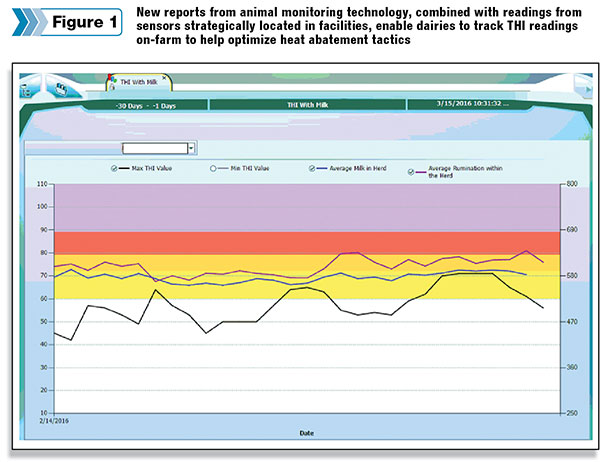The negative effects of heat stress take a big chunk out of dairy farm coffers each season. The amount may be more or less, depending on the year, but estimates often put U.S. dairy industry losses to heat stress around $900 million annually.
Cow productivity suffers when ambient temperatures and relative humidity combine to create uncomfortable conditions for cows. First, feed intake drops, followed by reduced milk production and other physical responses like increased panting and changes in eating patterns.
Dairy experts further explain that other biological changes – such as those in the endocrine system and the increase in maintenance requirements – also contribute to the reduction in energy available for milk production.
Lower reproductive performance – which lingers months after temperatures drop – is another unwelcome effect from heat stress.
Cooling effects
Heat abatement tools – including fans, sprinklers, shade, increased access to water and fine-tuning rations – have helped dairies significantly reduce economic losses from heat stress conditions.
“Dairies with elevated levels of cooling are better able to mitigate the effects of heat stress,” notes Brent Robinson, dairy nutritionist with Cargill and partner in Paramount Dairy near Caro, Michigan.
“This is particularly noticeable the hottest part of the summer and when dairies typically have the most variation in feed intake and the health issues that go along with that challenge.”
However, some farms and dairy advisers have begun tapping data from animal monitoring systems to find opportunities to alleviate the impacts of heat stress and increase herd efficiency even more. The end goal is to use the information to enhance heat abatement strategies across the herd or for individual groups of animals (Figure 1).
Heat stress ties to rumination
Recently, researchers in Italy quantified a correlation between heat stress and rumination time. Results published in the August 2013 issue of the Journal of Dairy Science show that rumination time was negatively affected by heat stress conditions.
Specifically, rumination time began to decrease as the daily maximum temperature-humidity index (THI) rose to the 76 to 77 THI threshold.
The researchers also found that these results could be related to the effects of heat stress on energy balance, dry matter intake and cows’ daily pattern of eating. The results support the use of rumination time as a heat stress marker.
Its measurement during periods of increased temperatures and humidity provides useful information on the potential impact of heat stress.
The research indicates changes in cow rumination can act as an early warning sign for the implementation of cow cooling strategies.
Animal monitoring data, rather than thermometers, may offer dairies a better way to determine when heat abatement strategies should be implemented or tweaked to improve cow responses and increase animal comfort.
For example, dairy managers may potentially use rumination data to turn cooling systems on earlier. Rumination data may show more effective results on a dairy when heat abatement begins at 75ºF rather than waiting for temperatures to rise to 80ºF.
“Doing so will require monitoring within a tighter window to see effects rather than using the system to track daily or group rumination results,” Robinson says. “We have a lot to learn in this area.”
Group targets
In the future, the predictive data may also be used to pinpoint specific areas on the dairy where heat stress management should be tweaked to reduce negative impacts.
For example, rumination monitoring can show the effectiveness of cooling on cow groups – like dry cows. Heat abatement for lactating cows is generally considered a standard practice, but dry cows do not always reap the same advantages.
Yet research repeatedly shows dry cows significantly benefit from cooling strategies.
Results published in the October 2015 issue of the Journal of Dairy Science show that compared to cooled cows, heat-stressed dry cows exhibited:
- Higher rectal temperatures
- Greater respiration rates
- Decreased dry matter intake
In addition, heat stress reduced rumination times (243.2 minutes per day for heat-stressed cows versus 282.5 minutes per day for the cooled cows) and chewing times. The trial was conducted during the three weeks prior to calving.
The cooled cows achieved higher milk production than the heat-stressed cows – production for the cooled cows was 98 pounds of milk per day while the heat-stressed cows produced 89 pounds of milk per day.
Nutrition check
Rumination monitoring has also become a valuable tool to verify nutrition strategies to help reduce the effects of heat stress.
“The data is especially helpful data to show the effects of variation in feeding times and ration changes,” says Robinson. “Even the deviation of an hour or two can really throw rumination off, and I can see whenever a ration change occurs.”
Of course, discrepancies in feed delivery can happen at any time but may be especially troubling during hot summer days.
In addition, there’s interest by some dairy advisers in simultaneously tracking rumination time and ambient temperature to determine when to increase ration potassium levels or other nutrition strategies to reduce the effects of heat stress.
That’s because it’s well-known that heat-stressed cows are prone to rumen acidosis and other health challenges due to increased metabolic stress. Since rumination data can predict health challenges up to 48 hours prior to the appearance of physical symptoms, this information provides crucial information for early interventions when necessary.
Finally, rumination data may also be used to find “hot spots” on the dairy where heat abatement actions could be improved. It may be especially helpful to illustrate the need for – or effectiveness of – cooling strategies in holding pens, return alleys or other key areas in need of attention, again provided the information is evaluated in a timely fashion.
“There is much to learn with these systems,” says Robinson. “The longer the system is in place, the more we discover what it can teach us. We have more to learn about interpreting the information it provides.”
Still, the more dairy farms and their advisers harness the power of rumination data, the more ways they find to incorporate it into management strategies. The ability to use rumination data to improve cow health, comfort and management increases with each data point monitored. The ability to improve the success of heat abatement strategies will be a likely benefit as dairies gain experience and expertise in animal monitoring systems. PD

-
Gláucio Lopes
- Large Herd Manager & Reproduction Specialist
- SCR Dairy, Inc.
- Email Gláucio Lopes






